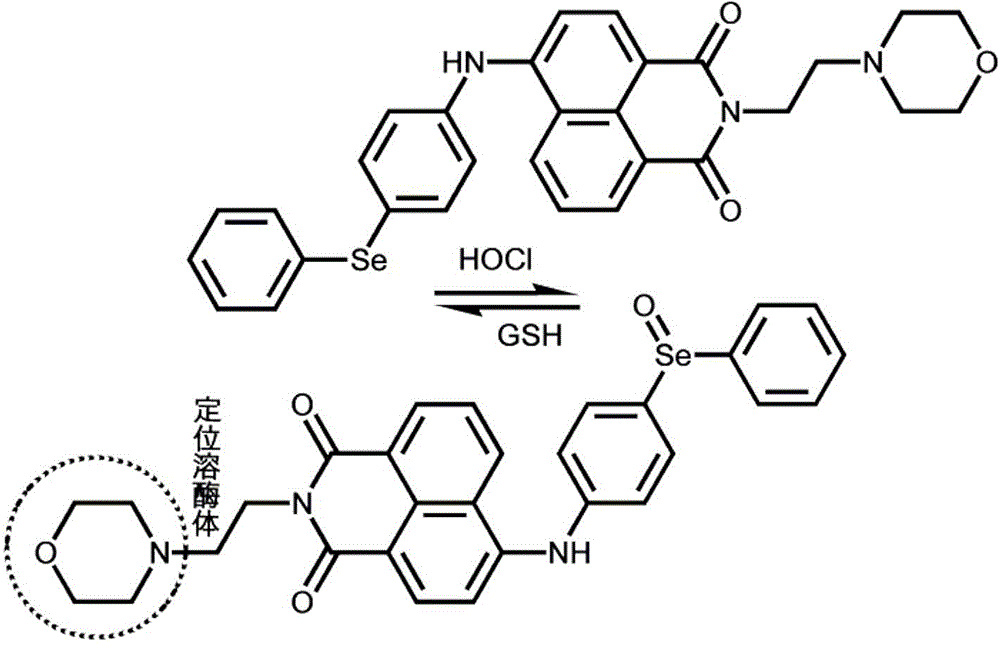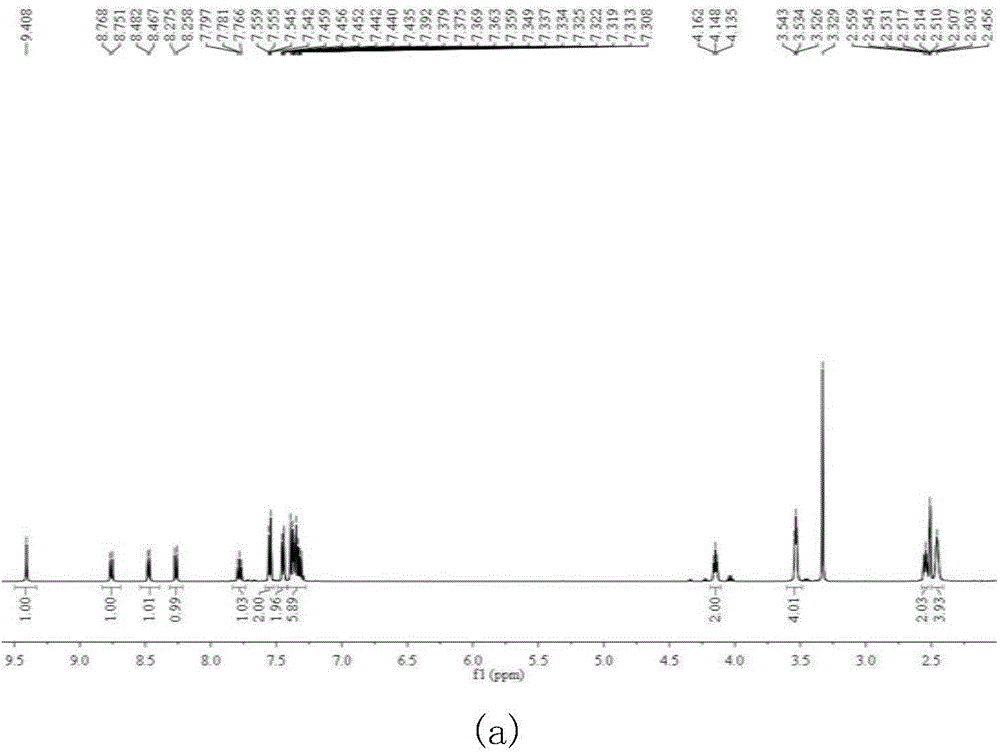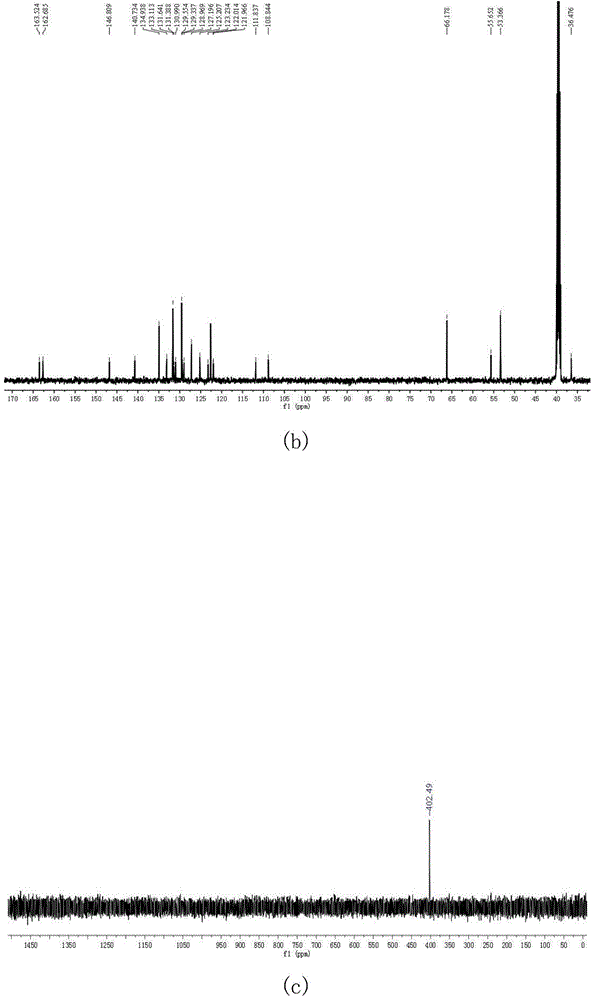Fluorescent probe and application thereof in detection of hypochlorous acid in cytolysosome
A technology for detecting hypochlorous acid and fluorescent probes, which is applied in the field of fluorescent probes and can solve problems such as the inability of probes to be positioned
- Summary
- Abstract
- Description
- Claims
- Application Information
AI Technical Summary
Problems solved by technology
Method used
Image
Examples
Embodiment 1
[0020] Embodiment 1 (synthesis of probe):
[0021] Such as image 3 As shown, the structure of the probe compound used in the embodiment is represented by the code Lyso-NI-Se.
[0022] Synthesis of Lyso-NI-Se: Add 0.50g 4-phenylselenium-aniline, 0.40g cuprous iodide and 0.80g nitrogen-(ethylaminomorpholine)-4-bromo-1,8-naphthoyl to a 50mL three-neck flask Imine, 0.10g potassium hydroxide, vacuum / nitrogen replacement three times, add 20ml anhydrous dimethyl sulfoxide, turn on magnetic stirring, raise the temperature to 90°C, and react for 60 minutes. Filtrate, evaporate the filtrate under reduced pressure, dissolve with dichloromethane, filter again and evaporate the filtrate to dryness under reduced pressure, and purify the resulting solid by silica gel column chromatography (using dichloromethane and ethyl acetate as eluent) to obtain the target compound Lyso-NI-Se (red solid). 1H NMR (500MHz, d 6 -DMSO) δ(ppm):9.41(s,1H),8.76(d,1H,J=8.5Hz),8.47(d,J=7.5Hz,1H),8.27(d,1H,J=...
Embodiment 2
[0023] Embodiment 2 (Lyso-NI-Se selectivity to hypochlorous acid):
[0024] Add 4000μL phosphate buffer solution (pH=5.0, concentration 0.1M), 4000uL Lyso-NI-Se acetonitrile solution (10μM), and 80μL active oxygen solution to a 10mL colorimetric tube, mix well and add 3mL solution to In a 1cmⅹ1cmⅹ4cm cuvette, measure the fluorescence emission spectrum of the working solution, λex=430nm, the grating width is 5nm, 4nm.
[0025] The experimental results of the selectivity of Lyso-NI-Se to HClO are as follows: Figure 4 As shown, the ordinate represents the fluorescence intensity at a wavelength of 540nm. image 3 It shows that Lyso-NI-Se has good selectivity to HClO, and the fluorescence of the system is significantly enhanced. Under the assay conditions, compared to HClO, the fluorescence enhancement caused by other reactive oxygen species (the equivalent far exceeds HClO) is negligible.
Embodiment 3
[0026] Example 3 (quantitative detection of hypochlorous acid by Lyso-NI-Se):
[0027] Add 4000μL phosphate buffer solution (pH=5.0, concentration 0.1M), 4000uL Lyso-NI-Se acetonitrile solution (10μM), 80μL solutions containing different concentrations of hypochlorous acid into a 10mL colorimetric tube, mix After homogenization, take 3mL of the solution and add it to a cuvette of 1cmⅹ1cmⅹ4cm, and measure the ultraviolet-visible absorption spectrum and fluorescence emission spectrum of the working solution (λex=430nm, grating width 5nm, 4nm).
[0028] Figure 4 It was shown that the probe could detect hypochlorous acid at physiological levels in humans. Changes of absorption spectrum (a) and fluorescence spectrum (b) with the addition of hypochlorous acid (0 to 8.0 μM), and the fluorescence intensity at 540nm increases with the increase of hypochlorous acid addition (c).
[0029] Figure 5 It shows that under the lysosome pH condition of pH 4.0 to 5.5, the fluorescence of Ly...
PUM
 Login to View More
Login to View More Abstract
Description
Claims
Application Information
 Login to View More
Login to View More - R&D
- Intellectual Property
- Life Sciences
- Materials
- Tech Scout
- Unparalleled Data Quality
- Higher Quality Content
- 60% Fewer Hallucinations
Browse by: Latest US Patents, China's latest patents, Technical Efficacy Thesaurus, Application Domain, Technology Topic, Popular Technical Reports.
© 2025 PatSnap. All rights reserved.Legal|Privacy policy|Modern Slavery Act Transparency Statement|Sitemap|About US| Contact US: help@patsnap.com



